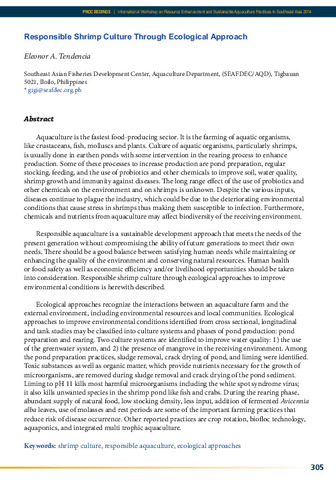Responsible shrimp culture through ecological approach
- Global styles
- MLA
- Vancouver
- Elsevier - Harvard
- APA
- Help
Share
นามธรรม
Aquaculture is the fastest food-producing sector. It is the farming of aquatic organisms, like crustaceans, fish, molluscs and plants. Culture of aquatic organisms, particularly shrimps, is usually done in earthen ponds with some intervention in the rearing process to enhance production. Some of these processes to increase production are pond preparation, regular stocking, feeding, and the use of probiotics and other chemicals to improve soil, water quality, shrimp growth and immunity against diseases. The long range effect of the use of probiotics and other chemicals on the environment and on shrimps is unknown. Despite the various inputs, diseases continue to plague the industry, which could be due to the deteriorating environmental conditions that cause stress in shrimps thus making them susceptible to infection. Furthermore, chemicals and nutrients from aquaculture may affect biodiversity of the receiving environment.
Responsible aquaculture is a sustainable development approach that meets the needs of the present generation without compromising the ability of future generations to meet their own needs. There should be a good balance between satisfying human needs while maintaining or enhancing the quality of the environment and conserving natural resources. Human health or food safety as well as economic efficiency and/or livelihood opportunities should be taken into consideration. Responsible shrimp culture through ecological approaches to improve environmental conditions is herewith described.
Ecological approaches recognize the interactions between an aquaculture farm and the external environment, including environmental resources and local communities. Ecological approaches to improve environmental conditions identified from cross sectional, longitudinal and tank studies may be classified into culture systems and phases of pond production: pond preparation and rearing. Two culture systems are identified to improve water quality: 1) the use of the greenwater system, and 2) the presence of mangrove in the receiving environment. Among the pond preparation practices, sludge removal, crack drying of pond, and liming were identified. Toxic substances as well as organic matter, which provide nutrients necessary for the growth of microorganisms, are removed during sludge removal and crack drying of the pond sediment. Liming to pH 11 kills most harmful microorganisms including the white spot syndrome virus; it also kills unwanted species in the shrimp pond like fish and crabs. During the rearing phase, abundant supply of natural food, low stocking density, less input, addition of fermented Avicennia alba leaves, use of molasses and rest periods are some of the important farming practices that reduce risk of disease occurrence. Other reported practices are crop rotation, biofloc technology, aquaponics, and integrated multi trophic aquaculture.
Description
Abstract only.
การอ้างอิง
Tendencia, E. A. (2015). Responsible shrimp culture through ecological approach. In M. R. R. Romana-Eguia, F. D. Parado-Estepa, N. D. Salayo, & M. J. H. Lebata-Ramos (Eds.), Resource Enhancement and Sustainable Aquaculture Practices in Southeast Asia: Challenges in Responsible Production of Aquatic Species: Proceedings of the International Workshop on Resource Enhancement and Sustainable Aquaculture Practices in Southeast Asia 2014 (RESA) (p. 305). Tigbauan, Iloilo, Philippines: Aquaculture Department, Southeast Asian Fisheries Development Center.
Type
Conference paperISBN
9789719931041




